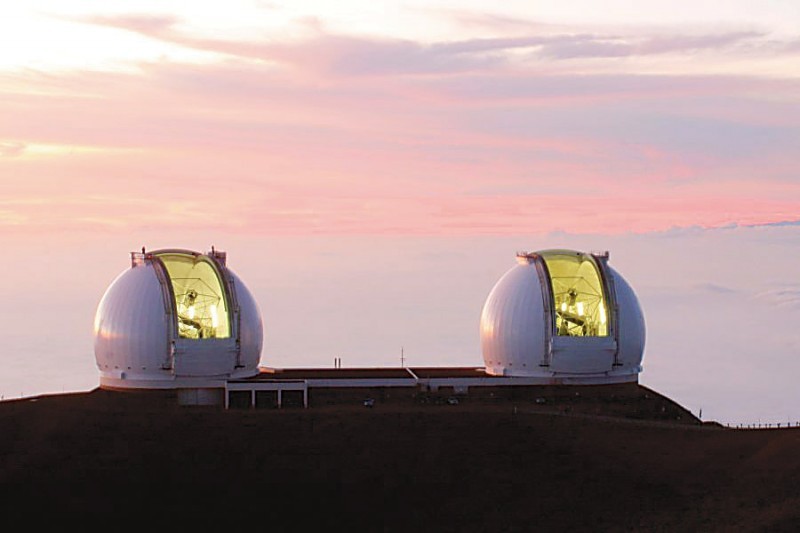The hunt for ET
Astronomers at the Keck Observatory in Hawaii have found a planet orbiting a distant star that could support life.
October 12, 2010
I’m not sure how many students at Iowa State stay up to date on the latest space science news. But, if you don’t pay attention to what scientists are learning about the galaxies beyond our atmosphere, the recent big news was that a group of astronomers had used the Keck Observatory in Hawaii to find a planet orbiting a distant star that could be much like Earth. This causes me to ponder the question “Will we discover other life forms in space in my lifetime?”
After that discovery, I think my answer has to be a guarded “yes.” Why? Well, the fact that we discovered a planet outside of our solar system in the “goldilocks zone” — the orbital area where we believe life can exist —is not the biggest part of this news story. The biggest part of the story is that this planet was found after the researchers had studied only nine of the few hundred stars that are closest to Earth.
The fact that they found a planet similar to Earth so quickly amazed even the astronomers conducting the experiment. With an estimated 100 billion stars in our galaxy alone, finding a goldilocks-zone planet orbiting the ninth star they decided to look at is quite astounding. We’ll have to find a few more planets in this zone to figure out what the true average occurrence of goldilocks-zone planets is, but at this rate, there could be hundreds of thousands — conservatively — in our Milky Way galaxy alone.
Now, it’s quite a trick to observe planets orbiting stars because of the blinding brightness of the stars themselves. The recent news comes courtesy of an investigation that uses a technique that investigates the radial velocities — or “wobbles” — of stars to determine what planetary masses are tugging on each star.
Another technique that compliments the first is to closely examine the light coming from the stars over time to “see” the slight dimming of that light when a planet passes between us and the star. The issue is that the planet must be orbiting in a plane where it passes between its star and our Earth observatories.
Sadly, this isn’t the case with the planet found by astronomers last week — Gliese 581g — which has an orbit that doesn’t bring it between its star and Earth, where our new Kepler space telescope could take a look at it. That means that we can’t detect the planet’s size or whether it has the right mix of elements to support life there. But, with this early discovery, it’s likely that we will soon find other planets orbiting nearby stars that we can study closely for the telltale signs of life.
Then, of course, we will have to examine whether or not to try to contact any intelligent life that exists in our galaxy or the universe. Recently, Stephen Hawking said this would be a bad idea, though in reality, we’ve been sending various “hello” messages — and advertisements for Doritos — into space for more than 35 years. Some Russians actually said hi to the Gliese system back in 2008 — and the message should get there in 2029.
For this question, I’m not sure if I should side with Hawking or Alexander Zaitsev, a Russian scientist who has sent out many of humanity’s messages to the cosmos. It would be a bad thing if we sent all these messages and managed to bring a hostile, intelligent space-faring alien species to Earth to investigate a la “Independence Day.” But, it would be helpful if a benevolent alien species responded to our messages, offering higher technological and scientific knowledge and becoming our space pen pals of sorts.
In the end I would side with Hawking and be a bit wary of sending messages to the stars until we at least have a way of reaching nearby planets and nearby stars and might have some chance of fending off interstellar attackers.
Looking again at the search for life beyond Earth, I believe that we will eventually fund a follow-up mission to the Kepler Mission to supplement the observations being made right now from Kepler and Earth. In the next few years, a mission like the Terrestrial Planet Finder mission will materialize and do the last bit of detective work on planets similar to Gliese 581g. But, in the meantime, maybe we’ll decide to send explorers to Mars where they might find microbial life beneath the Martian soil.
In any case, it’s a very exciting time for those of us who are interested in new discoveries light-years beyond Earth. And who knows, we could find alien life forms or receive messages from space even sooner than decades from now if we discover new techniques for investigating nearby stars. Unless science provides me with new surprises in the interim, I’ll just be waiting on the early scientific results of the Kepler Mission that are rumored to be planned for publication around February 2011.
Hopefully when we do discover life it will be of the friendly or harmless variety. Otherwise, we may be in need of a Will Smith character to save the day. Any volunteers?

















